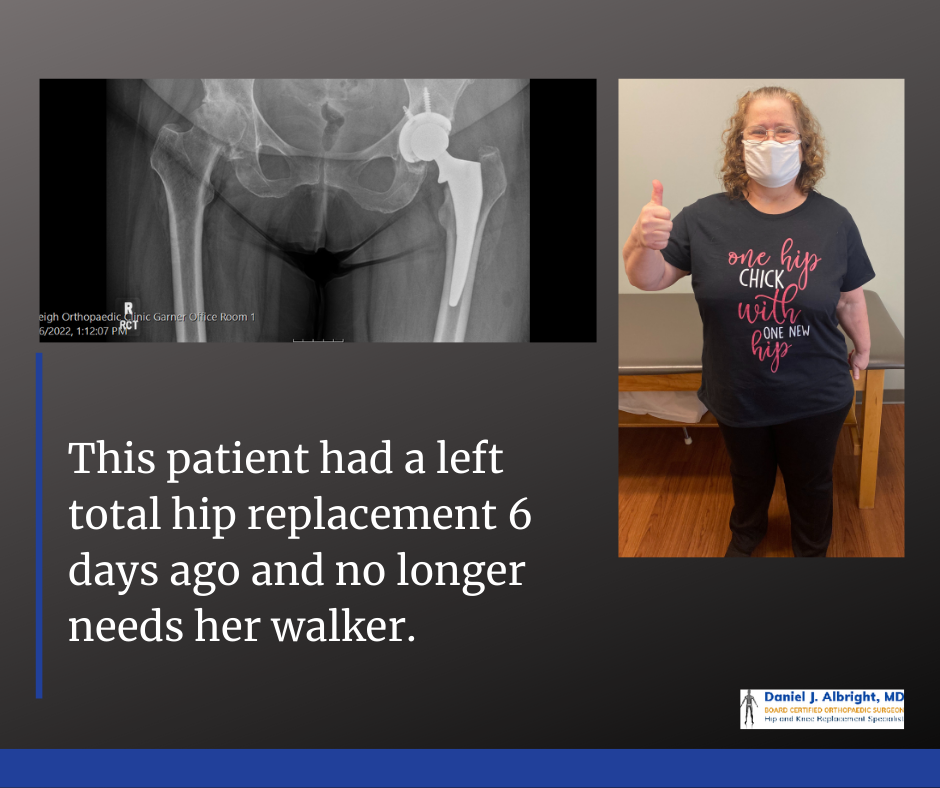Anterior Hip Replacement
Anterior Hip Replacement is a minimally invasive, muscle sparing surgery using an alternative approach to traditional hip replacement surgery. Traditionally, the surgeon makes the hip incision laterally, on the side of the hip, or posteriorly, at the back of the hip. Both approaches involve cutting major muscles to access the hip joint. With the anterior approach, the incision is made in front of the hip enabling the surgeon to access the hip joint without cutting any muscles. A special operating table is used that facilitates various anatomical positions enabling the surgeon to replace the hip joint anteriorly.
Benefits of Anterior Hip Replacement
Potential benefits of anterior hip replacement, compared to traditional hip replacement surgery, may include the following:
- Smaller incision
- Minimal soft tissue trauma
- Reduced post op pain
- Less blood loss
- Shorter surgical time
- Faster healing time
- Less scarring
- Earlier mobilization
- Less post operative restrictions
- Reduced hip dislocations
- Decreased hospital stay
While not everyone is a candidate for this minimally invasive procedure, it is a great choice for many suffering from degenerative hip problems, including osteoarthritis. Patients tend to experience less pain, have fewer restrictions on movement than with traditional hip replacement, and are moving around quickly.
Read this blog > The Benefits of Anterior Hip Replacement Over Traditional Methods
The Surgical Procedure for Anterior Hip Replacement
Preparing for Hip Replacement Surgery. Anterior Hip Replacement is performed in a hospital operating room under general or regional anesthetic depending on you and your surgeon’s preference. You will be placed supine, on your back, on a special operating table that enables the surgeon to perform your hip replacement anteriorly. Flouroscopic imaging is used during the surgery to ensure accuracy of component positioning and to minimize leg length inequality.
The surgeon makes one incision to the front of the hip, about 4 inches long. The surgeon then pushes the muscles aside to access the hip joint to begin the replacement. At no time during the surgery are any muscles cut.
The femur (thigh bone) is separated from the acetabulum (hipbone socket).The acetabulum (socket) is prepared using a special instrument called a reamer. The acetabular component is then inserted into the socket. This is sometimes reinforced with screws or occasionally cemented.
A liner, which can be made of plastic, metal or ceramic material, is then placed inside the acetabular component. The femur (thigh bone) is then prepared. The femoral head which is arthritic is cut off and the bone prepared using special instruments to exactly fit the new metal femoral component.
The femoral component is then inserted into the femur. This may be press fit relying on bone to grow into it or cemented depending on a number of factors such as bone quality and surgeon’s preference. The real femoral head component is then placed on the femoral stem. This can be made of metal or ceramic. The artificial components are fixed in place.
The surgeon withdraws the instruments and sutures the incision closed. The incision is then covered with a sterile dressing.
Read this blog > Comprehensive Guide to Anterior Hip Replacement
Post Operative Care
After surgery, your hip replacement surgeon will give you guidelines to follow. It is important that you follow your surgeons’ instructions for a safe and successful outcome.
Normally, after a traditional hip replacement, your surgeon would give you instructions on hip precautions to prevent dislocating the new joint. Hip precautions are very restrictive and usually include the following:
- Avoid the combined movement of bending your hip and turning in your foot.
- You should sleep with a pillow between your legs for 6 weeks.
- Avoid crossing your legs and bending your hip past a right angle.
- Avoid low chairs.
- Avoid bending over to pick things up. Grabbers are helpful as are shoe horns or slip-on shoes.
- An elevated toilet seat should be used.
Anterior Hip Replacement Resources
5 Ways to Prevent Hip Problems as You Age
How to Prevent Hip Replacement Complications Post Surgery
When to See an Orthopedic Doctor for Hip Pain






